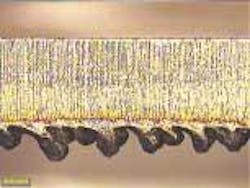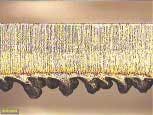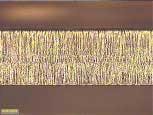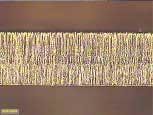Cold forming cutting nozzles
Using laser cutting nozzles that have been cold formed improves cutting speed and cut quality
Cold forming is a process for making shaped metal parts that involves no heat or metal cutting. In cold forming, the material is swaged around a mandrel having the desired shape and surface finish. Unlike other machining methods, such as screw machines, the part is completely free from tool marks and other surface imperfections.
A highly exact manufacturing process, cold forming delivers unmatched part-to-part repeatability. In fact, the interior form is within 1 micron from one part to the next. This is due to precise conformation to the contours of the mandrel used to form the material. The result is an ultra-smooth surface finish on critical interior surfaces of less than 0.08 micron RMS and overall exterior tolerances of ±50 microns.
Laser Mechanisms (Farmington Hills, MI) recognized the advantages of using a cold forming process to manufacture laser cutting nozzles, in particular with the major benefit of the extremely smooth surface finish on the inside of the nozzle.
"Our first batch of cold formed nozzles was absolutely beautiful," recalls Glenn Golightly, Laser Mechanism's industrial general manager. "The inner surface has a polished mirror finish that is so reflective that it's almost hard to see the hole at the end when looking through the tip. We had Schlieren images taken of the gas flow through these nozzles and they immediately confirmed the effect of removing all the imperfections from machining a nozzle. As you can see in the photos, the Mach Disc shock wave is totally eliminated. We knew right away that the cutting results with these nozzles would be significantly improved."
The laser cutting nozzle (also known as the gas jet tip) is a simple, yet essential, component of a laser cutting system. In many ways, over the years, it has become a commodity item, sold mainly on price and availability with an abundance of suppliers. The well recognized copper nozzle is fairly easily machined, and in superficial ways is similar to those used in other conventional cutting and welding processes.
Golightly notes the commodity aspect of the current laser nozzle market, "A gas jet tip that cost $60 20 years ago fell to half that price over ten years, and since then has dropped to a cost of only a few dollars. While lower prices are certainly a great development for the consumer, volumes have increased to the point where new tip suppliers have entered the market, often with no knowledge of the intricacies of laser processing. Cutting performance is greatly affected by the quality of the nozzle. Cold formed nozzles may cost slightly more than conventionally machined nozzles, but they have performance advantages that add up to large cost savings."
Scott Kiser, of Laser Maintenance Group, LLC (Lakesite, TN) found that to be true, "We changed out the tips (to cold formed nozzles) and got some amazing results. The cold formed tip not only left a vastly better edge quality, it was faster too."
Another laser job shop reported an increase in cutting speed on 7-gauge thick stainless steel, going from 48 ipm to 58 ipm, an improvement of more than 20 percent. In addition, the company also was able to turn its laser power down by about 150 watts.
Improved cut quality and faster cutting speed with no change in parameters are also important benefits to consider. As Kiser notes, "With the recent increases in steel prices, these nozzles will easily pay for themselves even if they yielded just one more part that would normally have been lost with the old style tips." But there are even further benefits to the cold formed nozzles.
"Users may find that the better laminar flow through the nozzle will allow a more precise optimization of the process," Golightly points out. "Gas consumption could possibly be reduced, which is another cost savings. Tip standoff and cutting speed can all be re-examined."
Cold forming also allows the use of pure oxygen-free high conductivity (OFHC) copper as the raw material for constructing the tip. OFHC copper has several percent higher reflectivity to CO2 and Nd:YAG wavelengths than free machining tellurium copper used for conventionally machined nozzles (99.8 percent versus 97.5 percent). This reduces, or even eliminates, damage from misaligned laser beams or workpiece reflections striking the nozzle. Also unlike tellurium copper, OFHC copper can be easily polished to achieve shiny, smooth surfaces on the outside of the nozzle, thus reducing adhesion of cutting residues.
"These nozzles should last longer and need replacement less often," Golightly says. "And with such part-to-part consistency in their manufacture, there can also be reduced set-up on changeovers. Most importantly, they allow laser cutters to run closer to their optimum performance speeds and cut qualities. Taken together, the cost savings can add up to hundreds, or even thousands of dollars of extra productivity per nozzle life."
Mike DelBusso is a sales engineer with Laser Mechanisms, Farmington Hills, MI. Contact him by e-mail at [email protected].



